3.2.1 Description and other sections
According to Rule 42 of the European Patent Convention: "(1) The description shall:
-
specify the technical field to which the invention relates;
-
indicate the background art which, as far as is known to the applicant, can be regarded as useful to understand the invention, draw up the European search report and examine the European patent application, and, preferably, cite the documents reflecting such art;
-
disclose the invention, as claimed, in such terms that the technical problem, even if not expressly stated as such, and its solution can be understood, and state any advantageous effects of the invention with reference to the background art;
-
briefly describe the figures in the drawings, if any;
-
indicate explicitly, when it is not obvious from the description or nature of the invention, the way in which the invention is industrially applicable.
-
briefly describe the figures in the drawings, if any;
(2) The description shall be presented in the manner and order specified in paragraph 1, unless, owing to the nature of the invention, a different presentation would afford a better understanding or be more concise."
Note The Description section is mandatory and may contain optional subsections.
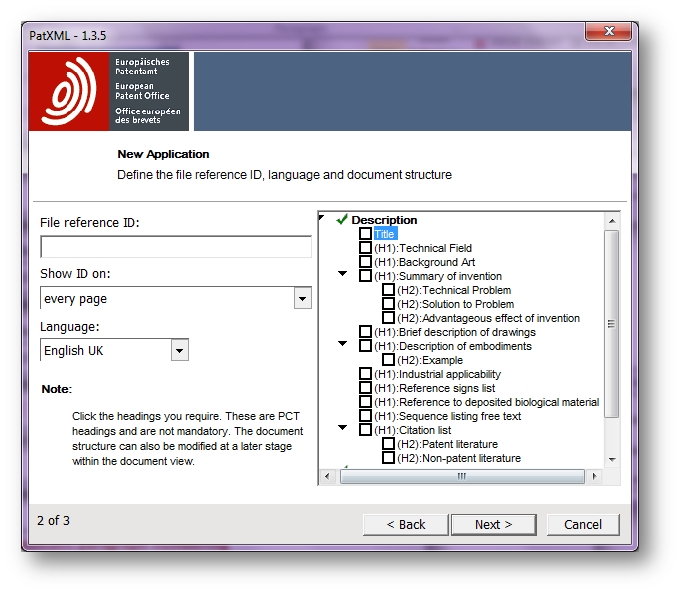
3.2.2 Invention title

The title:
- should clearly and concisely state the technical designation of the application
- should exclude elaborate names
- allows a maximum of 250 characters
- is not a mandatory section, though it is strongly recommended.
3.2.3 Technical field

Specify the technical field to which the invention relates. This information is mandatory, but the header is optional.
3.2.4 Background art
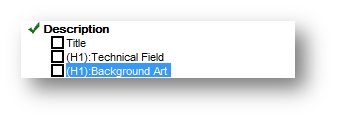
Indicate the background art which, as far as is known to the applicant, can be regarded as useful for understanding the invention, drawing up the European search report and examining the application, and, preferably, cite the documents reflecting such art.
3.2.5 Disclosure of the invention

Disclose the invention, as claimed, in such terms that the technical problem (even if not expressly stated as such) and its solution can be understood, and state any advantageous effects of the invention with reference to the background art.
See Article 83 of the European Patent Convention.
3.2.6 Brief description of drawings
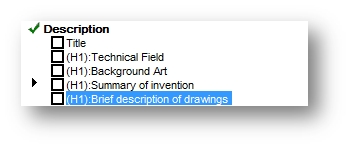
Briefly describe the figures in the drawings, if any. To learn how to insert drawings (figures), go to lesson: 2.3. How to insert images/figures
3.2.7 Best mode for carrying out the invention/Mode(s) for carrying out the invention
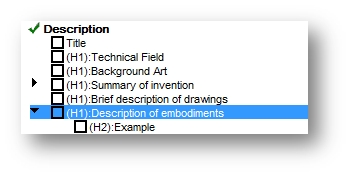
Describe in detail at least one way of carrying out the invention claimed, using examples where appropriate and referring to the drawings, if any.
3.2.8 Industrial applicability
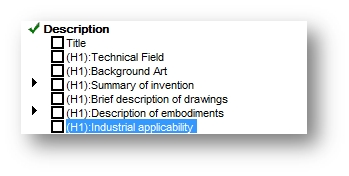
Indicate explicitly, when it is not obvious from the description or nature of the invention, the way in which the invention is capable of exploitation in industry.
The description should normally be presented in the manner and order specified, unless, owing to the nature of the invention, a different manner or order would afford a better understanding and a more economic presentation.
3.2.9 Sequence listing free text
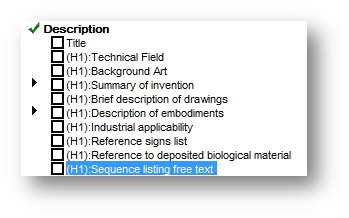
Sequence listings may be included in the Description section in accordance with and for the reasons described in Rule 30 of the European Patent Convention, which reads:
"Requirements of European patent applications relating to nucleotide and amino acid sequences
-
If nucleotide or amino acid sequences are disclosed in the European patent application, the description shall contain a sequence listing conforming to the rules laid down by the President of the European Patent Office for the standardised representation of nucleotide and amino acid sequences.
- A sequence listing filed after the date of filing shall not form part of the description.
- Where the applicant has not filed a sequence listing complying with the requirements under paragraph 1 at the date of filing, the European Patent Office shall invite the applicant to furnish such a sequence listing and pay the late furnishing fee. If the applicant does not furnish the required sequence listing and pay the required late furnishing fee within a period of two months after such an invitation, the application shall be refused."
This section is optional.
3.2.10 Claims
This is a mandatory section.
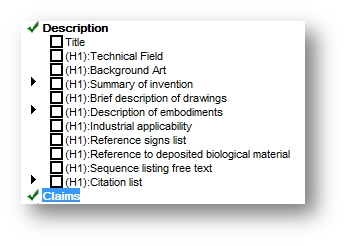
Rule 43 of the European Patent Convention states:
"(1) The claims shall define the matter for which protection is sought in terms of the technical features of the invention. Wherever appropriate, claims shall contain:
- a statement indicating the designation of the subject-matter of the invention and those technical features which are necessary for the definition of the claimed subject-matter but which, in combination, form part of the prior art;
-
a characterising portion, beginning with the expression “characterised in that” or “characterised by” and specifying the technical features for which, in combination with the features stated under sub-paragraph (a), protection is sought.
(2) Without prejudice to Article 82, a European patent application may contain more than one independent claim in the same category (product, process, apparatus or use) only if the subject-matter of the application involves one of the following:
- a plurality of interrelated products,
- different uses of a product or apparatus,
- alternative solutions to a particular problem, where it is inappropriate to cover these alternatives by a single claim.
(3) Any claim stating the essential features of an invention may be followed by one or more claims concerning particular embodiments of that invention.
(4) Any claim which includes all the features of any other claim (dependent claim) shall contain, if possible at the beginning, a reference to the other claim and then state the additional features. A dependent claim directly referring to another dependent claim shall also be admissible. All dependent claims referring back to a single previous claim, and all dependent claims referring back to several previous claims, shall be grouped together to the extent and in the most appropriate way possible.
(5) The number of the claims shall be reasonable with regard to the nature of the invention claimed. The claims shall be numbered consecutively in Arabic numerals.
(6) Except where absolutely necessary, claims shall not rely on references to the description or drawings in specifying the technical features of the invention. In particular, they shall not contain such expressions as “as described in part ... of the description”, or “as illustrated in figure ... of the drawings”.
(7) Where the European patent application contains drawings including reference signs, the technical features specified in the claims shall preferably be followed by such reference signs relating to these features, placed in parentheses, if the intelligibility of the claim can thereby be increased. These reference signs shall not be construed as limiting the claim."
See Article 84 of the European Patent Convention.
3.2.11 Abstract
This is a mandatory section. The text should be limited to 150 words.

Article 85 of the European Patent Convention states:
"The abstract shall serve the purpose of technical information only; it may not be taken into account for any other purpose, in particular for interpreting the scope of the protection sought or applying Article 54, paragraph 3."
Rule 47 of the European Patent Convention states:
"(1) The abstract shall indicate the title of the invention.
(2) The abstract shall contain a concise summary of the disclosure as contained in the description, the claims and any drawings. The summary shall indicate the technical field to which the invention pertains, and shall be drafted in a manner allowing the clear understanding of the technical problem, the gist of the solution of that problem through the invention, and the principal use or uses of the invention. The abstract shall, where applicable, contain the chemical formula which, among those contained in the application, best characterises the invention. It shall not contain statements on the alleged merits or value of the invention or on speculative applications thereof.
(3) The abstract shall preferably not contain more than one hundred and fifty words.
(4) If the European patent application contains drawings, the applicant shall indicate the figure or, exceptionally, the figures of the drawings which should be published with the abstract. The European Patent Office may decide to publish one or more other figures if it considers that they better characterise the invention. Each essential feature mentioned in the abstract and illustrated by a drawing shall be followed by a reference sign placed in parentheses.
(5) The abstract shall be drafted in such a manner as to constitute an efficient instrument for the purpose of searching in the particular technical field. In particular, it shall make it possible to assess whether consultation of the European patent application itself is necessary."
3.2.12 Drawings
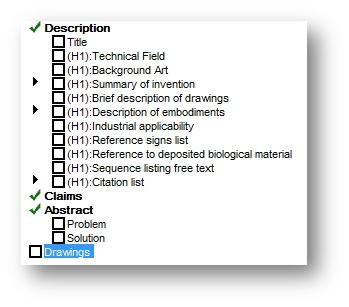
Rule 46 of the European Patent Convention states:
"(1) On sheets containing drawings, the usable surface area shall not exceed 26.2 cm x 17 cm. The usable or used surface shall not be surrounded by frames. The minimum margins shall be as follows:
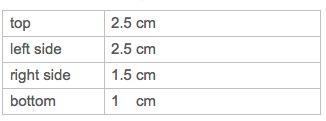
(2) Drawings shall be executed as follows:
- Drawings shall be executed without colourings in durable, black, sufficiently dense and dark, uniformly thick and well-defined lines and strokes.
- Cross-sections shall be indicated by hatching which should not impede the clear reading of the reference signs and leading lines.
- The scale of the drawings and their graphical execution shall be such that electronic or photographic reproduction with a linear reduction in size to two-thirds will allow all details to be distinguished without difficulty. If, exceptionally, the scale is given on a drawing, it shall be represented graphically.
- All numbers, letters, and reference signs appearing on the drawings shall be simple and clear. Brackets, circles or inverted commas shall not be used in association with numbers and letters.
- Generally, all lines in the drawings shall be drawn with the aid of drafting instruments.
- Elements of the same figure shall be proportional to one another, unless a difference in proportion is indispensable for the clarity of the figure.
- The height of the numbers and letters shall not be less than 0.32 cm. For the lettering of drawings, the Latin and, where customary, the Greek alphabets shall be used.
- The same sheet of drawings may contain several figures. Where figures drawn on two or more sheets are intended to form a single figure, the figures on the several sheets shall be so arranged that the whole figure can be assembled without concealing any part of the partial figures. The different figures shall be arranged without wasting space, preferably in an upright position, clearly separated from one another. Where the figures are not arranged in an upright position, they shall be presented sideways with the top of the figures at the left side of the sheet. The different figures shall be numbered consecutively in Arabic numerals, independently of the numbering of the sheets.
- Reference signs not mentioned in the description and claims shall not appear in the drawings, and vice versa. Reference signs to features shall be consistent throughout the application.
- The drawings shall not contain text matter. Where indispensable to understand the drawings, a few short keywords, such as “water”, “steam”, “open”, “closed” or “section on AB”, may be included. Any such keywords shall be placed in such a way that, if required, they can be replaced by their translations without interfering with any lines of the drawings.
(3) Flow sheets and diagrams shall be deemed to be drawings."
|
|
|